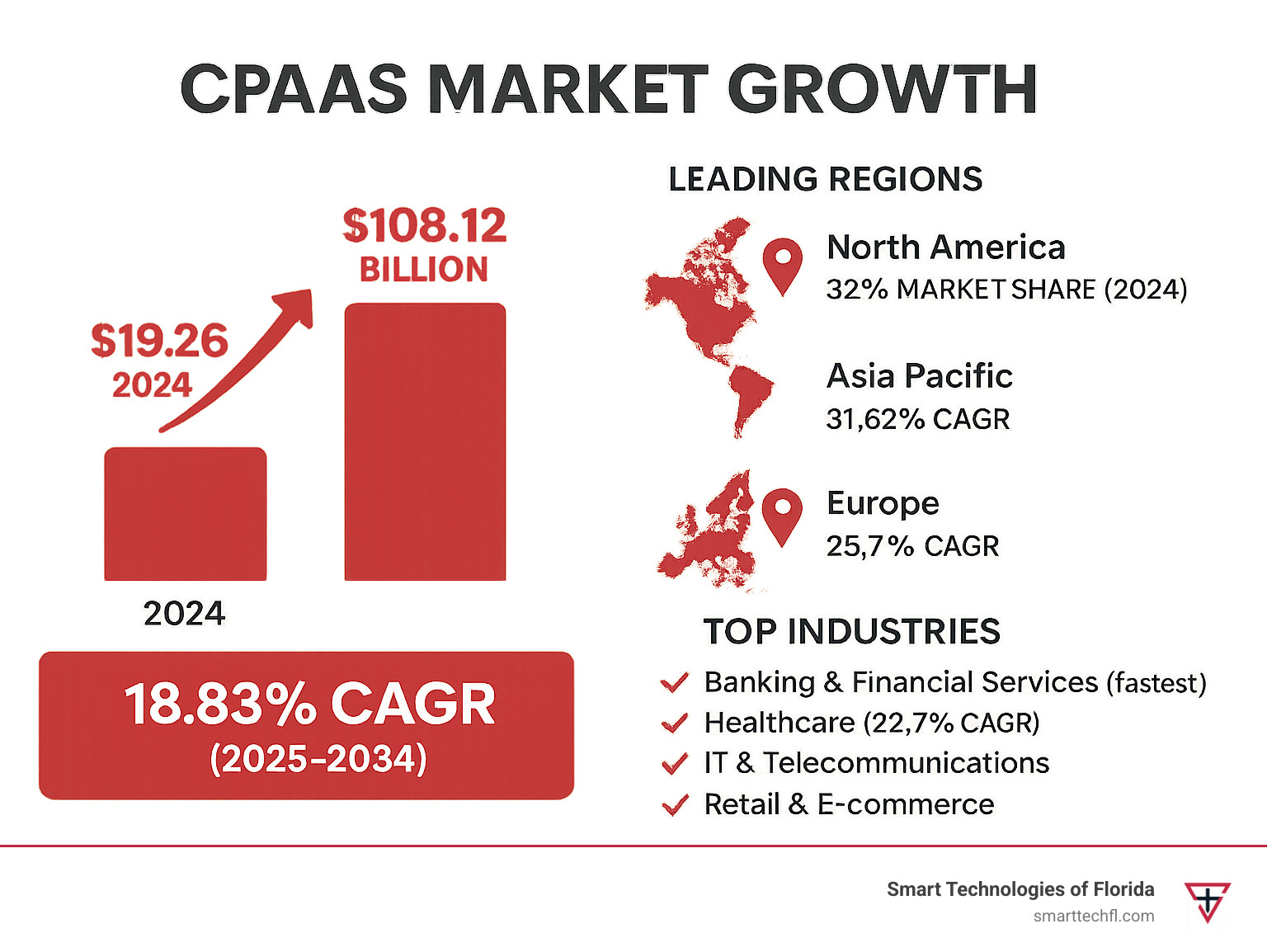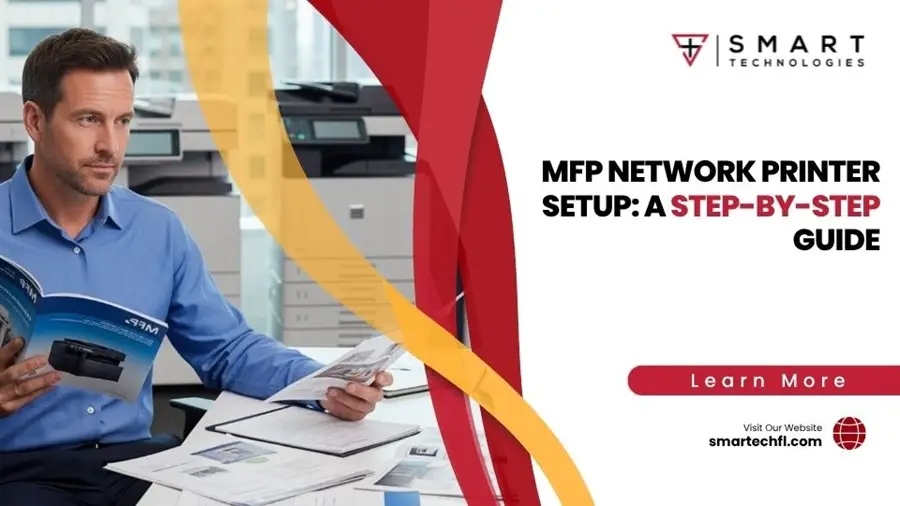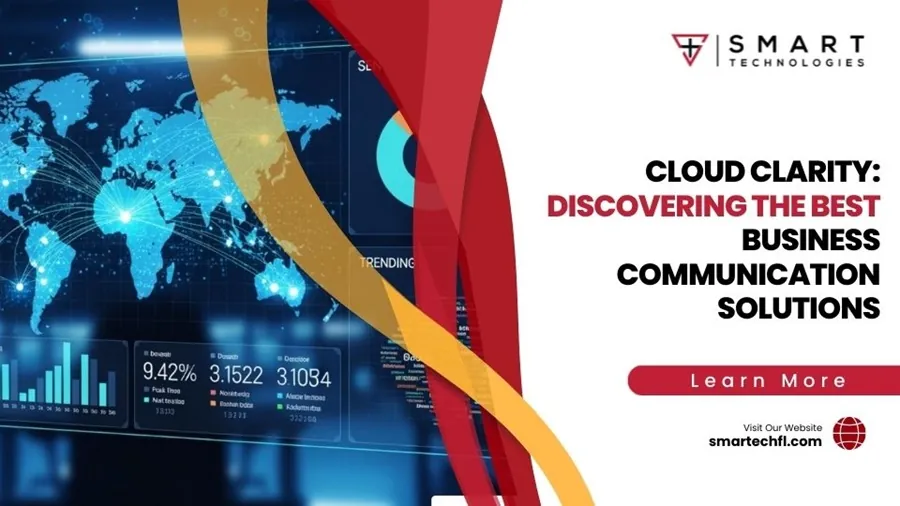CPaaS Market Insights: Growth, Trends, and Future Outlook
The CPaaS market is experiencing explosive growth as businesses seek better ways to connect with customers. Here’s what you need to know:
Market Size & Growth:
- Global CPaaS market valued at $19.26 billion in 2024
- Projected to reach $108.12 billion by 2034
- Growing at 18.83% CAGR (2025-2034)
Key Drivers:
- Demand for omnichannel communication
- Digital change acceleration
- Remote work adoption
- Cloud-based solution benefits
Leading Regions:
- North America: 32% market share (2024)
- Asia Pacific: Fastest growth at 31.62% CAGR
- Europe: 25.7% CAGR projected
Top Industries:
- Banking & Financial Services (BFSI)
- Healthcare (fastest growing at 32.7% CAGR)
- IT & Telecommunications
- Retail & E-commerce
The numbers tell a clear story. As one joint BCG-Meta survey found, 90% of Indonesian consumers prefer chat when interacting with brands. This isn’t just an Asian trend – it’s happening everywhere.
For mid-sized businesses, CPaaS offers something powerful: enterprise-grade communication tools without enterprise-level costs. You can add SMS notifications, video calls, or WhatsApp integration to your existing systems using simple APIs. No massive IT overhaul required.
The shift is real. Gartner predicts 90% of businesses will use CPaaS by 2028, up from 50% in 2023. Companies like AT&T saved 2 million work hours annually through API-led connectivity projects.

Decoding CPaaS: The Engine of Modern Business Communication
Think of CPaaS (Communication Platform as a Service) as your business communication Swiss Army knife. Instead of buying expensive hardware or building complex systems from scratch, you get a cloud-based toolkit that lets you add messaging, voice, and video features right into your existing apps and websites.
Here’s the beautiful part: you don’t need to become a telecom expert overnight. CPaaS providers handle all the heavy lifting – the servers, networks, and technical wizardry that make communication happen. Your team simply uses APIs (Application Programming Interfaces) and SDKs (Software Development Kits) to plug these features into your software.
It’s like having a master chef prepare all the ingredients while you focus on creating the perfect dish for your customers.
Let’s say you want to send SMS confirmations when customers place orders. Instead of figuring out carrier relationships and SMS gateways (trust us, it’s complicated), you just use a messaging API. The CPaaS market has evolved to make these integrations incredibly straightforward, even for businesses without massive IT teams.
This cloud-based platform approach transforms how companies handle communication channels. You’re not locked into rigid systems – you can adapt and scale as your business grows. For businesses exploring comprehensive solutions, our Business Communication Solutions page offers deeper insights into available options.
Core Components and Features
The real magic happens when you dive into what CPaaS can actually do. These aren’t just fancy tech features – they’re practical tools that solve real business challenges.
Messaging APIs form the backbone of most CPaaS implementations. SMS remains incredibly reliable for order updates, appointment reminders, and security codes. Nearly everyone has a phone that can receive texts, making it universally accessible.
RCS (Rich Communication Services) takes messaging to the next level. Think of it as SMS with superpowers – you can send high-quality images, create interactive buttons, and even verify your business identity. Customers see exactly who’s messaging them, which builds trust instantly.
WhatsApp Business API opens doors to conversational commerce, especially in regions where WhatsApp dominates daily communication. Your customers can ask questions, get support, and even make purchases without leaving their favorite messaging app.
Voice APIs bring the power of programmable calling to your business. Create smart phone systems that route calls intelligently, build interactive voice menus, or set up automated appointment confirmations. Our expertise in VoIP solutions pairs perfectly with these capabilities, giving you cost-effective voice communication that actually works.
Video APIs have become essential in our increasingly digital world. Whether you’re running telehealth appointments, providing face-to-face customer support, or hosting virtual consultations, embedded video calling keeps everything seamless within your existing workflows.
User verification through 2FA (two-factor authentication) protects both you and your customers. Send secure codes via SMS or use innovative flash call verification to confirm identities without friction.
Perhaps most exciting are the low-code and no-code tools that many CPaaS providers now offer. Your marketing team can build automated SMS campaigns without bothering the developers. Your customer service manager can create WhatsApp workflows using drag-and-drop interfaces.
This democratization of communication technology means every department can innovate, not just IT. Small and medium businesses especially benefit from this approach – you get enterprise-grade features without needing an enterprise-sized technical team.
The Explosive Growth of the Global CPaaS Market
The CPaaS market isn’t just growing – it’s absolutely exploding. Think of it like watching a rocket launch in slow motion, except this rocket has been accelerating for years and shows no signs of slowing down.
Let’s talk numbers, because they tell an incredible story. The global CPaaS market was valued at $19.26 billion in 2024, and here’s where it gets exciting – experts project it will skyrocket to $108.12 billion by 2034. That’s a compound annual growth rate of 18.83%, which in business terms is like finding a unicorn that also happens to be really good at math.
But wait, there’s more. Some research firms are even more optimistic, with growth rates consistently projected to exceed 25% annually over the coming years. What does this mean for businesses like yours? It means CPaaS has officially graduated from “nice-to-have tech toy” to “absolutely essential business foundation.”

So what’s driving this remarkable surge? It’s like a perfect storm of business needs all hitting at once.
First, there’s the unstoppable demand for omnichannel communication. Your customers don’t just want to text you, call you, or email you – they want to do all three, sometimes in the same conversation, and they expect it to feel seamless. CPaaS makes this possible without requiring a PhD in telecommunications.
Then there’s digital change, which has moved from boardroom buzzword to business survival necessity. Companies are ditching their clunky old communication systems faster than you can say “please hold while we transfer your call.” They need agile, cloud-native solutions that can keep up with customer expectations that seem to evolve weekly.
The shift to remote and hybrid work models has also turbocharged adoption. Remember when “working from home” meant checking email in your pajamas? Now it means running video conferences, managing team communications, and maintaining customer relationships from your kitchen table. CPaaS provides the robust, integrated tools that make this actually work.
Finally, the benefits of cloud adoption – scalability, flexibility, and cost-effectiveness – make CPaaS irresistible. It’s like having access to enterprise-grade communication superpowers without needing an enterprise-sized budget.
Regional Dynamics in the CPaaS Market
The CPaaS market might be global, but it’s fascinating to see how different regions are embracing this technology in their own unique ways.
North America has been leading the charge, holding approximately 32% of the market share in 2024. This makes sense – the region has always been quick to adopt new technologies, has solid cloud infrastructure, and businesses here have been digitally changing longer than most. It’s like being the first person in your neighborhood to get high-speed internet – you just have a head start.
But here’s where it gets really interesting: Asia Pacific is growing at a blistering 31.62% CAGR. This region is absolutely on fire when it comes to CPaaS adoption. Why? Picture this: you have massive mobile-first populations, smartphones everywhere, governments pushing digitalization, and a booming e-commerce scene where customers expect to chat their way through purchases. Countries like India and China aren’t just adopting CPaaS – they’re reinventing how business communication works.
Europe is taking a more measured but steady approach, with a projected 25.7% CAGR. European companies are particularly focused on security and privacy APIs, making sure they stay compliant with regulations like GDPR. They’re proving you can grow fast while still dotting every i and crossing every t.
Latin America is showing impressive adoption too, with companies heavily investing in messaging APIs that work with popular local chat apps. It’s a region that really gets the power of conversational commerce.
According to new research from Juniper, the global market is expected to reach $29 billion by 2025, highlighting just how universal this technology’s appeal has become.
Key Industry Verticals Driving the CPaaS Market
What’s beautiful about CPaaS is its chameleon-like ability to transform communication in virtually any industry. But some sectors are really leading the revolution.
Banking, Financial Services, and Insurance (BFSI) companies have been early adopters and remain major drivers. Think about it – when your bank sends you a fraud alert or when you get that two-factor authentication code, that’s CPaaS at work. These institutions need communication that’s not just fast, but secure and reliable. A delayed transaction alert isn’t just inconvenient – it could be costly.
Healthcare is projected to be the fastest-growing vertical, with some estimates showing 32.7% CAGR. The pandemic accelerated telehealth adoption from “someday maybe” to “we need this yesterday.” CPaaS enables everything from appointment reminders to secure video consultations to patient monitoring communications. It’s literally changing how healthcare providers connect with patients.
Retail and E-commerce businesses are using CPaaS to transform the entire customer journey. From that “your order is on its way” text to abandoned cart reminders that actually convert, retailers are finding that good communication isn’t just customer service – it’s a competitive advantage. Some companies are even enabling customers to change delivery times by simply replying to a text message.
IT and Telecommunications companies naturally dominate market share, since they’re often both providers and heavy users of CPaaS. They’re using it internally while also powering other businesses’ communication needs.
The Transportation and Logistics sector loves CPaaS for real-time tracking and delivery updates. Meanwhile, education is embracing it for student communications and virtual learning environments.
Want to see CPaaS in action across different industries? Check out our detailed CPaaS Examples for Business Communication to see how businesses are actually using these tools to transform their operations.
Key Trends and Future Outlook: What’s Next for CPaaS?
The CPaaS market is like watching the future of business communication unfold in real time. At Smart Technologies of Florida, we’ve witnessed how rapidly this landscape shifts. What seemed cutting-edge last year becomes standard practice today. So where is all this heading?
The biggest game-changer? AI integration is changing everything we thought we knew about customer communication. We’re not just talking about simple chatbots anymore. The CPaaS market is becoming the backbone for generative AI and conversational AI that can actually hold meaningful conversations with your customers. Imagine a system that doesn’t just answer questions but understands emotions, predicts what customers need, and routes them to the right solutions automatically.
This AI revolution is making businesses smarter in ways that seemed impossible just a few years ago. Natural language processing now enables conversations that feel genuinely human. Sentiment analysis helps companies understand when a customer is frustrated before they even say so. And predictive engagement means reaching out to customers at exactly the right moment with exactly what they need.
Here’s a number that stopped us in our tracks: Gartner predicts that 80% of businesses will use CPaaS for generative AI in their customer experience strategies by 2028. That’s not just growth – that’s a complete change of how companies communicate.
Network APIs represent another exciting frontier. Think of it this way: telecom operators are opening up their networks like never before. Developers can now tap directly into network capabilities – guaranteeing quality of service, allocating bandwidth in real-time, even accessing location data. For businesses running latency-sensitive applications like high-definition video streaming, this is revolutionary.
The trend toward industry-specific innovation is making CPaaS more accessible than ever. Instead of generic APIs that require extensive customization, providers are creating pre-built solutions custom for specific industries. A healthcare provider can now implement telehealth communication features in weeks, not months. An events company gets tools designed specifically for managing attendee interactions throughout the entire event lifecycle.
Meanwhile, emerging channels continue to expand the communication landscape. While SMS and voice calls remain essential, businesses are embracing WhatsApp Business, RCS messaging, and even video streaming for technical support and compliance verification. The CPaaS market is adapting to meet customers wherever they prefer to communicate.

Every technological revolution brings both problems and possibilities. The CPaaS market is no exception, and understanding both sides helps businesses make smarter decisions.
Let’s be honest about the challenges first. Data security and privacy concerns keep many business leaders awake at night. When sensitive customer information flows through cloud-based communication platforms, one security breach can devastate a company’s reputation. Regulations like GDPR and HIPAA add layers of complexity that require careful navigation.
Integration complexity remains another real headache. While APIs are designed to simplify embedding communication features, connecting CPaaS with existing enterprise systems often requires significant technical expertise. We’ve seen companies struggle to integrate new communication tools with their legacy CRM or ERP systems. It’s rarely the plug-and-play experience that marketing materials suggest.
The pricing pressure in today’s competitive landscape creates its own set of challenges. With dozens of CPaaS providers competing for market share, businesses face choice paralysis. Meanwhile, providers struggle to differentiate themselves beyond price, leading to a race to the bottom that can compromise service quality.
But here’s where it gets exciting. The opportunities far outweigh these challenges.
SME adoption represents a massive growth opportunity. Small and medium-sized enterprises can now access enterprise-grade communication tools without enterprise-level budgets. Pay-as-you-go pricing models and low-code tools mean a local retailer can implement the same sophisticated customer engagement strategies as a Fortune 500 company.
The demand for personalized customer engagement is creating unprecedented opportunities for businesses willing to innovate. Customers don’t just want good service – they expect experiences custom specifically to their needs and preferences. CPaaS enables this level of personalization at scale, turning every customer interaction into an opportunity to build stronger relationships.
Digital change continues accelerating across every industry we serve. Companies that once resisted cloud adoption are now embracing it out of necessity. This shift creates enormous opportunities for businesses ready to leverage CPaaS solutions strategically.
The key is viewing these challenges as stepping stones rather than roadblocks. Strong security protocols, simplified integration approaches, and continuous innovation with AI and emerging channels transform obstacles into competitive advantages. For more insights on how cloud solutions can transform your business operations, explore our guide on Cloud Business Communications Benefits.
CPaaS vs. UCaaS vs. CCaaS: Choosing the Right Solution
Walking into business communication solutions can feel like entering an alphabet soup kitchen. CPaaS, UCaaS, CCaaS – what do all these acronyms actually mean for your business? More importantly, which one fits your specific needs?
Think of these three solutions as different tools for different jobs. CPaaS is like having a fully equipped workshop where you can build exactly what you need. It provides APIs and SDKs that developers use to embed communication features directly into your existing applications. Need to add SMS notifications to your e-commerce platform? Want to integrate video calls into your healthcare app? CPaaS gives you the building blocks to create custom solutions that fit your exact requirements.
UCaaS takes a completely different approach. It’s the ready-to-use, comprehensive communication system that brings everything together in one package. Think business phone systems, video conferencing, instant messaging, and collaboration tools all unified in a single platform. UCaaS focuses on internal communication – helping your team work together more effectively, whether they’re in the office or working remotely.
CCaaS specializes in one crucial area: managing customer interactions. It’s designed specifically for contact centers and customer service operations. CCaaS provides omnichannel support, intelligent call routing, workforce optimization, and detailed analytics to help businesses deliver exceptional customer service.
Here’s how they compare in practical terms:
| Feature | CPaaS | UCaaS | CCaaS |
|---|---|---|---|
| Primary Function | Build custom communication features | Unified internal communication | Customer service management |
| Delivery Model | APIs for custom integration | Complete cloud platform | Contact center suite |
| Target User | Developers, businesses needing customization | Internal teams and employees | Customer service agents |
| Customizability | Highly customizable | Moderate configuration options | Workflow customization available |
The beauty is that these solutions aren’t mutually exclusive. Many successful businesses use combinations of all three. A growing company might use UCaaS for internal team collaboration, CCaaS for customer support operations, and CPaaS to embed specific communication features into their mobile app.
At Smart Technologies of Florida, we help businesses steer these choices based on their unique goals and operational needs. The right solution depends on factors like your technical resources, budget, growth plans, and specific communication challenges. Understanding these differences ensures you invest in technology that actually solves your problems rather than creating new ones.
For a deeper dive into comprehensive communication strategies, check out our insights on Unified Communications Solutions.
Frequently Asked Questions about the CPaaS Market
At Smart Technologies of Florida, we’ve had countless conversations with business owners about the CPaaS market. After 23 years of helping companies steer digital change, we’ve noticed the same questions come up again and again. Let’s tackle the big ones that keep our clients curious.
What is the main driver of CPaaS market growth?
The biggest force behind CPaaS market growth? It’s simple: customers want choice. They want to text you, call you, video chat with you, or message you on WhatsApp – whatever feels natural to them in that moment.
Think about your own behavior. When you need quick customer service, do you always want to call? Sometimes you just want to fire off a quick text or hop into a chat window. Your customers feel the same way.
This demand for omnichannel communication is pushing businesses to rethink everything. Companies are realizing they can’t just stick with phone calls and emails anymore. They need to meet customers where they already are, on their preferred channels.
The broader digital change trend is adding fuel to this fire. Businesses are ditching old, clunky systems for flexible, cloud-based solutions that can actually keep up with changing customer expectations. Plus, the shift to cloud adoption means companies can access powerful communication tools without breaking the bank or overhauling their entire IT infrastructure.
How is AI impacting the CPaaS industry?
AI isn’t just changing the CPaaS market – it’s completely revolutionizing it. We’re seeing businesses slash their operating costs while dramatically improving response times through AI-powered chatbots and virtual assistants.
But here’s where it gets really exciting: these aren’t the frustrating, robotic chatbots from a few years ago. Modern natural language processing (NLP) makes conversations feel genuinely human-like. The AI can understand context, pick up on customer emotions through sentiment analysis, and even predict what someone might need before they ask.
We’re also seeing incredible advances in predictive engagement. The system learns from every interaction, getting smarter about routing customers to the right person or resource. Some platforms can even spot potential fraud patterns, adding an extra layer of security that wasn’t possible before.
The result? Personalized customer interactions that feel authentic, helpful analytics that actually drive business decisions, and automation that works so well your customers might not even realize they’re talking to AI.
Is CPaaS suitable for small businesses?
This might be our favorite question because the answer is a resounding yes! CPaaS is perfect for small and medium-sized enterprises (SMEs), and here’s why it’s such a game-changer.
Remember when enterprise-grade communication tools were only for big corporations with massive IT budgets? Those days are gone. The cloud-based nature of CPaaS, combined with pay-as-you-go pricing models, means small businesses can access the same powerful communication features that Fortune 500 companies use.
You can start small – maybe just adding SMS notifications to your existing website – and then scale up as your business grows. Need video calls for customer support? Add that later. Want to integrate WhatsApp for international customers? No problem.
The emergence of low-code and no-code tools is another huge win for SMEs. Your team doesn’t need to become coding experts overnight. Many platforms now offer drag-and-drop interfaces that let you build sophisticated communication workflows without writing a single line of code.
This scalability and flexibility mean small businesses can compete on customer experience in ways that simply weren’t possible before. You can deliver the kind of personalized customer engagement that builds real loyalty, all while keeping costs manageable and operations efficient.
Conclusion: The Future of Business Communication is Composable
The CPaaS market story we’ve explored together paints a picture of incredible change. We’ve witnessed market projections climbing toward $100 billion, fueled by businesses desperately seeking better ways to connect with their customers. This isn’t just about numbers on a spreadsheet – it’s about real companies finding they can finally build communication tools that actually fit their needs.
What makes this revolution so exciting is how composable everything has become. Businesses no longer have to accept one-size-fits-all solutions that never quite work right. Instead, they can pick and choose the exact communication features they need – whether that’s SMS alerts, video calls, or AI-powered chatbots – and weave them seamlessly into their existing systems.
The AI integration we discussed isn’t science fiction anymore. It’s happening right now, making customer conversations smarter and more personal. Companies are saving millions of hours while their customers get faster, better service. That’s the kind of win-win scenario that makes this technology so compelling.
For businesses of all sizes, CPaaS has become what we call a strategic IT asset. It’s not just another tool in the toolbox – it’s the foundation that lets companies innovate faster, serve customers better, and adapt quickly when markets change.
At Smart Technologies of Florida, we’ve spent 23 years helping organizations steer these kinds of changes. Our people-centric approach means we don’t just throw technology at problems. We take the time to understand your unique challenges and goals, then craft solutions that actually work for your team and your customers.
The future of business communication really is composable, and it’s arriving faster than most people realize. The question isn’t whether your business will need these capabilities – it’s whether you’ll be ready when your competitors start using them.
Ready to stop playing catch-up and start leading the pack? Upgrade your business phone systems today and let’s build something amazing together. Your customers are waiting to hear from you – let’s make sure you’re speaking their language.












